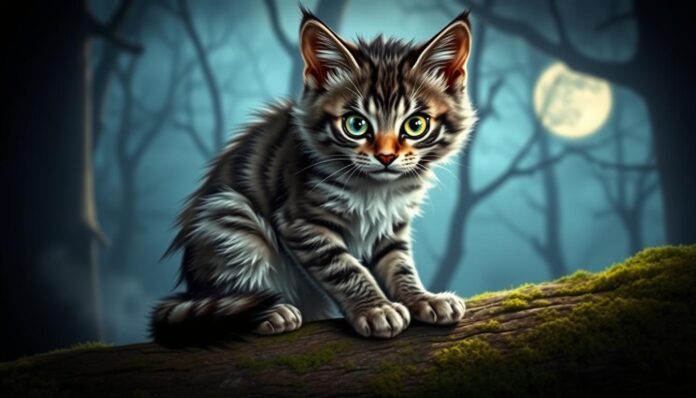Dr. Antonio DeMarco has seen only 2 or 3 Lykoi cats in his 15 years. This shows how rare this unique cat breed is. The Lykoi, known as “werewolf cats,” caught the world’s attention with their wolf-like look. They come from a natural mutation in domestic cats in the United States.
Brittney Gobble, a veterinarian in Vonore, Tennessee, developed the Lykoi breed. It was first shown in 2012 by The International Cat Association (TICA). Now, the Cat Fanciers’ Association (CFA) welcomes Lykoi cats of all colors for competitions starting in 2023-2024.
Understanding the Lykoi: Origin and Evolution
The Lykoi breed, also known as the “werewolf cat,” started from a natural genetic mutation. This happened in domestic cat populations over the last 20 years. Their unique look, with a sparse coat and yellow eyes, comes from this rare genetic change.
The Greek Wolf Connection
The name “Lykoi” comes from the Greek word “lycos,” meaning “wolf.” This name shows how much the breed looks like the mythical werewolf. It has caught the attention of cat lovers all over the world.
Discovery and Development Timeline
The Lykoi breed was first found in 2010 in Virginia and Tennessee. DNA tests showed they weren’t related to other hairless breeds like the Sphynx or Devon Rex. A lot of genetic and health checks were done to make sure the breed was safe and healthy.
Natural Mutation Origins
The Lykoi’s special look comes from a natural genetic mutation in domestic cats. This mutation affects their hair growth, making them look sparse and patchy. Their thin coats make them sensitive to cold, which is why this mutation is rare in feral cats.
Physical Characteristics of the Werewolf Cat
The Lykoi, also known as the “werewolf cat,” has a unique look. They have a roan coat pattern and are partially hairless. Lykoi cats are about 8 to 10 inches tall and weigh 6 to 12 pounds, similar to other small- to medium-sized cat breeds.
They have a mix of colored and white hairs on their body. Their face, tail, and legs are usually solid-colored. Their fur may look coarse but feels surprisingly smooth. Lykoi kittens shed their coat before growing it back, adding to their werewolf cat features.
| Characteristic | Lykoi Cat |
|---|---|
| Lifespan | 12 to 15 years |
| Height | 8 to 10 inches |
| Weight | 6 to 12 pounds |
| Coat Length | Hairless, short |
| Shedding Amount | Frequent |
| Coat Colors | Black / ebony |
| Coat Patterns | Color point, solid |
The lykoi appearance and partially hairless features make them special. Many pet owners love them for their unique look.
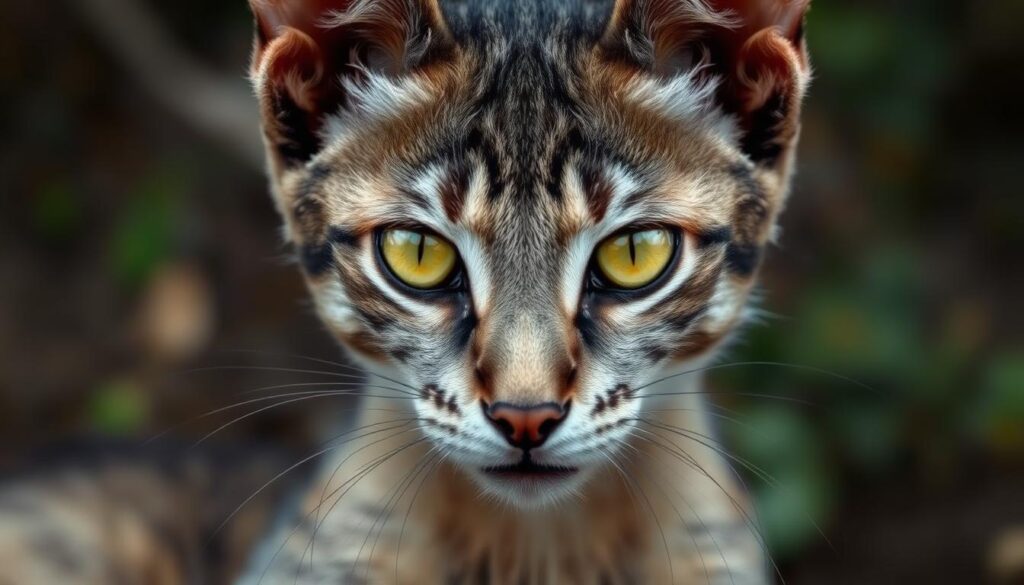
You May Like:- Ukrainian Levkoy vs Sphynx: Hairless Cat Comparison
The Unique Coat Pattern and Hair Loss Cycle
The Lykoi cat has a special lykoi coat pattern. It’s a mix of colored and white hairs. This roan pattern looks like a “werewolf-like” appearance, with dark black and white hairs.
The Lykoi’s coat is unique because of a genetic mutation. This leads to a special werewolf cat shedding process. During this time, the Lykoi can lose most of its hair, leaving only a small patch.
Seasonal Changes in Coat
The Lykoi’s coat also changes with the seasons. This is known as roaning in cats. The amount of hair and where it is can change with the weather.
| Coat Characteristic | Description |
|---|---|
| Lykoi Coat Pattern | Roan pattern with 30-70% dark black hair intermixed with white amelanistic hair, ideal 50/50 ratio |
| Coat Texture | Partially hairless with minimal undercoat and longer guard hairs covering the body |
| Molting Process (“Wolfing Out”) | Unique shedding cycle where the Lykoi can become almost completely bald, retaining only a small patch of hair |
| Seasonal Changes in Coat | The amount of hair and affected body parts may fluctuate due to environmental factors |
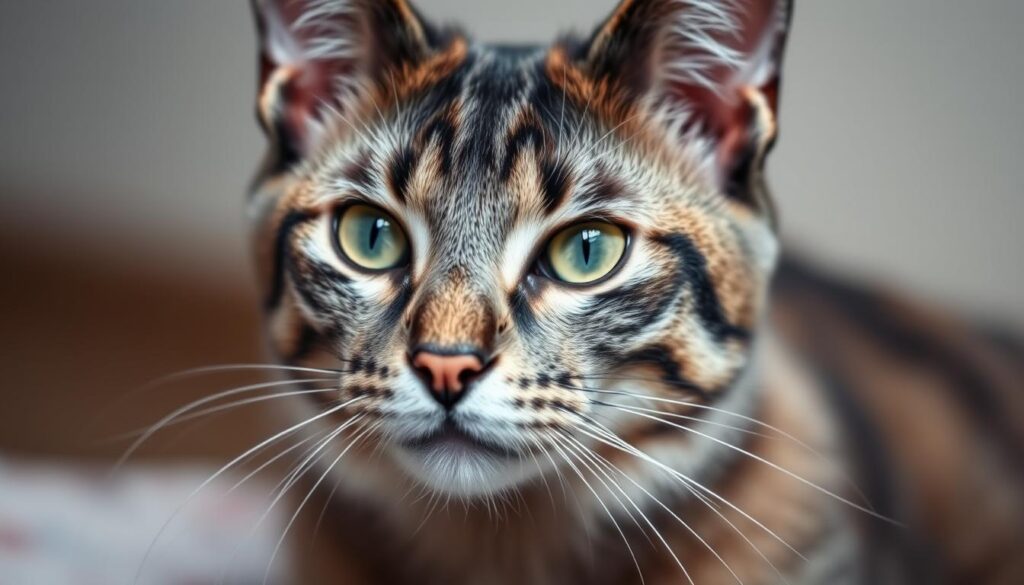
Lykoi Breed Standards and Recognition
The lykoi breed has become well-known in the cat world. In 2012, the International Cat Association (TICA) first recognized it. Then, in 2017, they gave it full Championship status. The Cat Fanciers’ Association (CFA) also welcomed lykoi cats for Championship status starting in 2023-2024.
The lykoi breed is known for its special coat, wedge-shaped head, and slender body. The black roan color is the main show standard for lykoi cats in TICA. TICA also suggests genetic testing for these cats to keep the breed healthy.
| Breed Standard Criteria | Scale of Points |
|---|---|
| Body | 20 points |
| Head | 20 points |
| Ears | 5 points |
| Eyes | 5 points |
| Coat, Texture, and Length | 40 points |
| Tail | 5 points |
| Condition | 5 points |
The lykoi breed is now found worldwide, with breeding in the U.S., Canada, and more. Research has found four lykoi gene variants. These genes help explain the breed’s unique traits and ongoing growth.
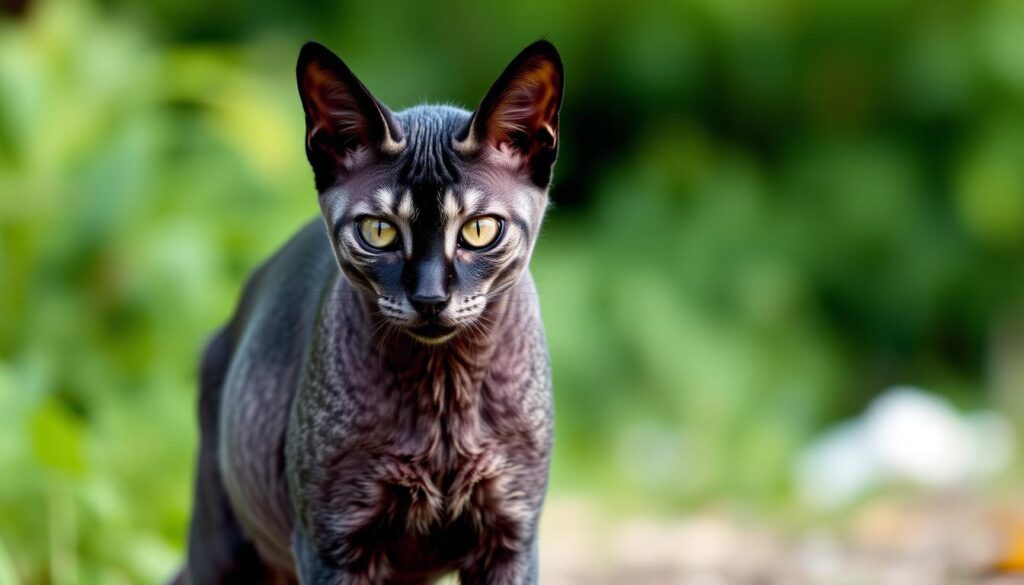
Temperament and Personality Traits
The Lykoi, known as the “werewolf cat,” has a unique and captivating personality. They are friendly, active, and very intelligent. Their strong prey drive makes them lively and engaging, perfect for families and those who want a loyal pet.
Social Behavior
Lykoi cats love to be around people and enjoy attention. They often follow their owners and like to cuddle. These cats also get along well with other pets, making them great for homes with multiple animals.
Intelligence and Training
Lykoi cats are very smart and can learn tricks easily. They are curious and love to please, making them easy to train. With the right play and mental challenges, they show off their problem-solving skills.
Compatibility with Families
Lykoi cats are great with families, including kids. They are playful and loving, adding fun to any home. But, they need to be watched around small pets to keep everyone safe.
In summary, Lykoi cats are intelligent, active, and have a special look. Their friendly nature makes them wonderful companions for those who can give them the care and stimulation they need.
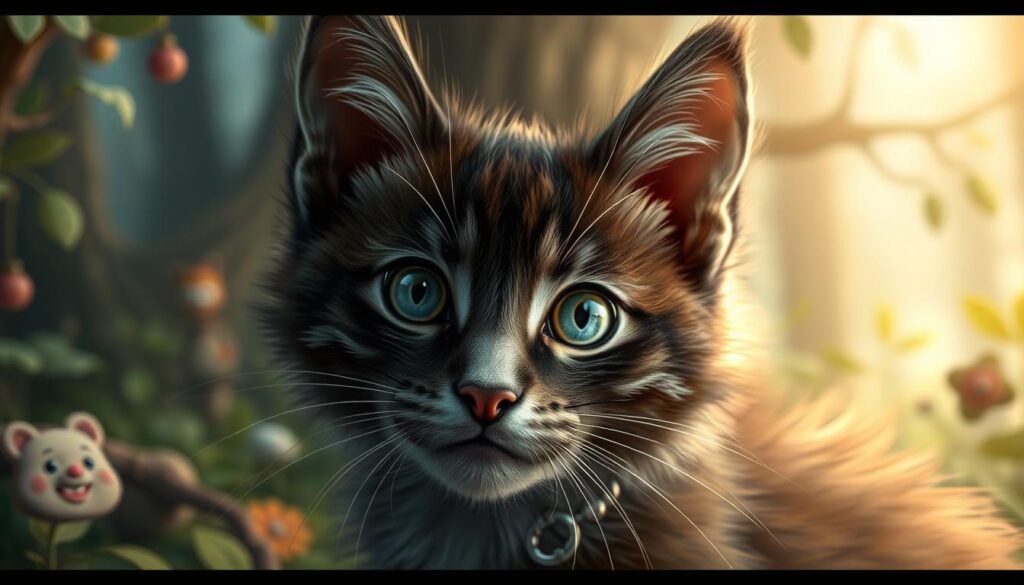
Health and Genetic Considerations
Lykoi cats, also known as the “werewolf cat,” are generally healthy. They live for 10 to 15 years on average. But, like all cats, they can face certain health problems.
Lymphocytic mural folliculitis is a big concern for Lykoi cats. It affects their unique coat and can cause hair loss, itching, and scabbing. Good breeders test for this to keep the breed healthy.
Lykoi cats might also get squamous cell carcinoma, a skin cancer. It often hits areas without hair, like ears and eyes. It’s important to watch for skin problems and see the vet often.
Because of achondroplastic dwarfism, Lykoi cats can get osteoarthritis as they get older. This means their joints can hurt. Keeping them active, at a good weight, and getting vet care helps a lot.
Lykoi cats can also get cold easily because they don’t have much fur. Keeping them warm and well-groomed is key to their health.
It’s vital to take your Lykoi cat to the vet regularly. Make sure they get all the shots and keep them safe from parasites. This way, they can live a happy and healthy life.
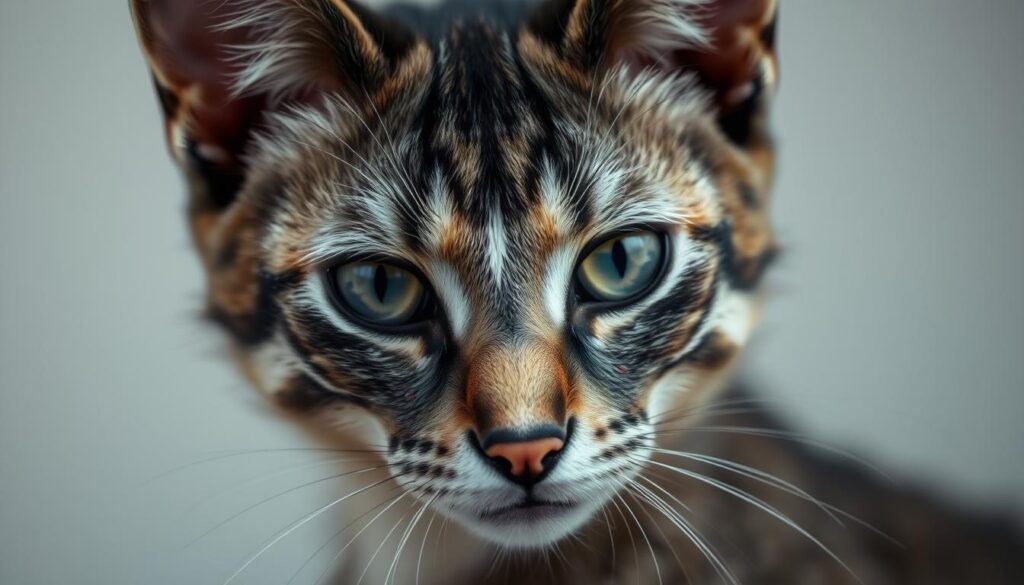
Essential Care Requirements
Lykoi cats, also known as “werewolf cats,” have a special look and grooming needs. They need regular care to stay healthy and happy. Their unique appearance and needs make them stand out from other cats.
Grooming Needs
Even though Lykoi cats have less fur, they need weekly brushing. This helps manage oil buildup and keeps their skin healthy. They might need occasional baths to keep their coat looking good.
It’s important to use a gentle, cat-safe shampoo. Avoid over-bathing, as it can harm their skin’s natural oils.
Dietary Requirements
Lykoi cats do best on high-quality, AAFCO-approved cat food. Kitten-specific formulas are best for young Lykoi to support their growth. A diet rich in omega-3 fatty acids helps keep their coat healthy.
For the best care, it’s wise to tailor their meals with a vet or nutritionist. This ensures they get the right lykoi cat care.
Environmental Considerations
Lykoi cats need special care because of their limited fur. They should avoid direct sunlight and stay in a comfortable temperature. Playing with them regularly and using interactive toys is key for their happiness and health.
Understanding and meeting Lykoi cats’ unique needs is vital. Proper werewolf cat grooming, balanced feline nutrition, and a good home environment are all important. This ensures they live a long, happy life.
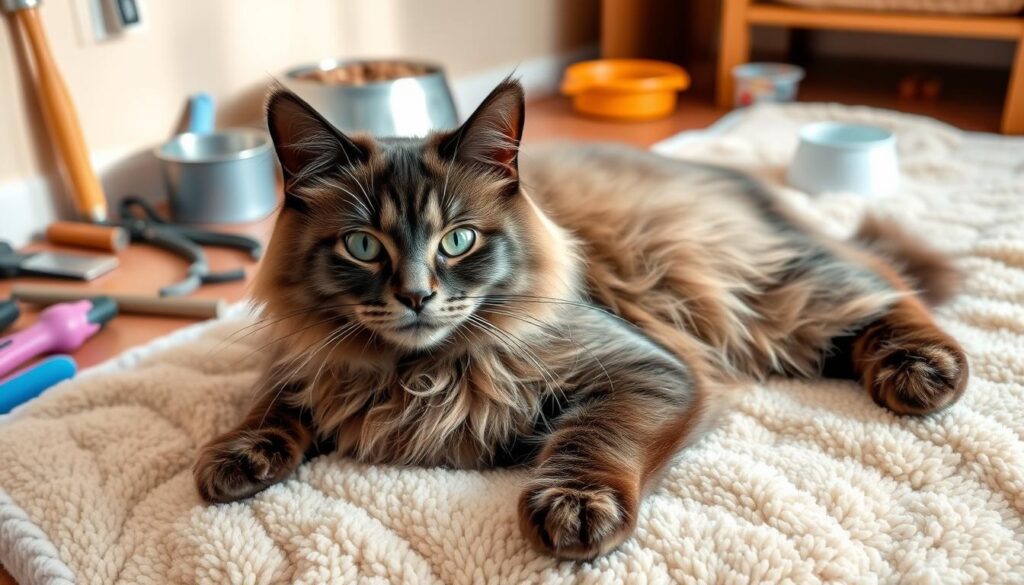
Breeding Program Development
The lykoi breeding program works hard to keep the breed’s special traits. It also makes sure there’s enough genetic variety. Breeders team up with experts like Dr. Leslie Lyons to learn more about the Lykoi gene through cat genetics research. They use black domestic shorthairs to widen the gene pool of this rare cat breed.
The program has grown, with Lykoi cats now in many countries. They keep studying the gene that makes Lykoi cats look so unique. This includes their special roaning pattern and how they molt.
In 2010, the “Gobble Family” in Tennessee began breeding Lykoi Cats, also known as Werewolf Cats. These cats have a genetic mutation that makes them look hairless. They can’t handle cold well because they don’t grow hair like other cats. So, they should live indoors.
The Lykoi breed was recognized by The International Cat Association (TICA) in 2012. It’s on its way to becoming a full Championship breed. The Gobbles, who started the Lykoi breed, have shared these cats with breeders in the USA, Canada, and France. This helps the breeding program grow.
| Lykoi Breeding Statistics | Value |
|---|---|
| Year Lykoi Breed Started | 2010 |
| TICA Recognition Year | 2012 |
| Current Breed Status | Preliminary New Breed |
| Countries with Lykoi Breeders | USA, Canada, France |
Conclusion
The Lykoi cat breed is a fascinating mix of looks and personality. They have a unique “werewolf” look and are friendly and fun to be around. As more people fall in love with these cats, they bring a special charm to our homes.
These cats have a special history, starting with Ray of Hope and Silver Lining in 2010. They faced some hurdles but are now recognized by the International Cat Association (TICA) as a Championship breed. They come in different colors and weigh between 8 to 13 pounds.
When thinking about getting a Lykoi, remember they need special care. They have a high prey drive and shed sometimes. They need a loving owner who can give them a great home. By understanding their needs, we can enjoy the unique bond with these “werewolf” cats.
FAQ
What are Lykoi cats?
Lykoi cats, also known as “werewolf cats,” are a special breed. They come from a natural mutation in domestic shorthair cats. Their coat is partially hairless with a roan pattern, making them look like wolves.
How did the Lykoi breed originate?
In 2010, Lykoi cats were found in Virginia and Tennessee. DNA tests showed they weren’t related to Sphynx or Devon Rex cats. Veterinarian Johnny Gobble officially started the breed in 2011, after lots of genetic and health checks.
What is the physical appearance of Lykoi cats?
Lykoi cats have a unique look. They have a roan coat and are partially hairless. They are small to medium-sized, standing 8-10 inches tall and weighing 6-12 pounds.
Their face, tail, and legs are mostly solid-colored. The body has a mix of colored and white hairs.
How do Lykoi cats’ coats change over time?
Lykoi cats go through a special molting process called “wolfing out.” They can become almost bald at times. The amount of hair loss and how often it happens varies.
Some Lykoi cats may keep a small patch of hair, like a mohawk, during molting. Seasonal changes can also change their coat and how much they shed.
What is the status of the Lykoi breed in cat associations?
Major cat associations have recognized the Lykoi breed. The International Cat Association (TICA) gave them “Registration Only” status in 2012. They got full Championship status in 2017.
The Cat Fanciers’ Association (CFA) accepted Lykoi cats for Championship status starting in 2023-2024.
What is the temperament of Lykoi cats?
Lykoi cats are friendly and active. They have a strong prey drive, thanks to their feral roots. They are smart and love to learn new tricks.
While they are affectionate, they prefer to be busy and active. They’re not always up for being lap cats.
What are the health considerations for Lykoi cats?
Lykoi cats are generally healthy, living 12-15 years on average. They can get lymphocytic mural folliculitis, a condition linked to their coat. Genetic tests have ruled out other health issues.
Dental disease is a concern, like with many cats. Regular vet visits are key to catch any health problems early.
What are the grooming and care requirements for Lykoi cats?
Lykoi cats need regular grooming, even with their sparse coat. They should be brushed weekly and bathed occasionally to keep their skin healthy. Their diet should be high-quality cat food, with kitten-specific formulas for young Lykoi.
They need protection from direct sunlight and a comfortable temperature due to their limited fur.
How is the Lykoi breed developed and maintained?
The Lykoi breeding program aims to keep their unique traits while ensuring genetic diversity. They outcross with black domestic shorthairs to widen the gene pool. Breeders work with geneticists, like Dr. Leslie Lyons, to understand the Lykoi gene better.
The program has grown globally, with Lykoi cats found in many countries.


